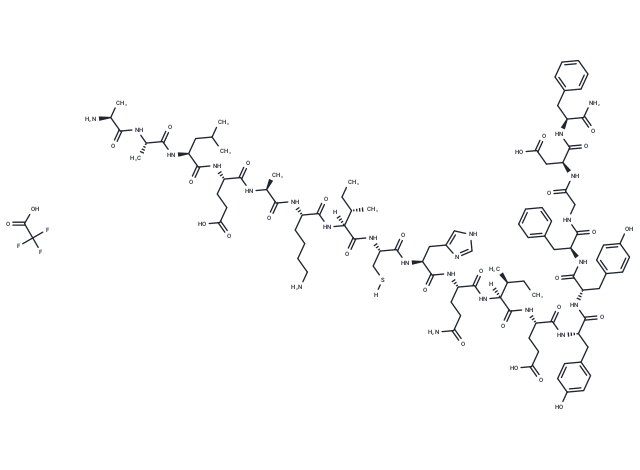- Remove All
 Your shopping cart is currently empty
Your shopping cart is currently empty
Shopping Cart
LAP TFA
Catalog No. T83714
Alias Lupus Autoantigen Peptide, La Peptide
Lupus autoantigen peptide (LAP), a derivative of the autoantigen La found in systemic lupus erythematosus (SLE) patients, spans amino acids 11-28 of La and functions as an antiviral peptide. It primarily blocks the hepatitis C virus (HCV) from interacting with internal ribosome entry site (IRES) trans-acting factors (ITAFs), notably the polypyrimidine tract-binding protein (PTB) and poly(rC)-binding protein 2 (PCBP2). In a Huh7 cell-based reporter assay, LAP at a concentration of 60 µM effectively hampers HCV IRES-mediated translation, a process reversible by adding recombinant forms of PTB and PCBP2.

LAP TFA
Catalog No. T83714Alias Lupus Autoantigen Peptide, La Peptide
Lupus autoantigen peptide (LAP), a derivative of the autoantigen La found in systemic lupus erythematosus (SLE) patients, spans amino acids 11-28 of La and functions as an antiviral peptide. It primarily blocks the hepatitis C virus (HCV) from interacting with internal ribosome entry site (IRES) trans-acting factors (ITAFs), notably the polypyrimidine tract-binding protein (PTB) and poly(rC)-binding protein 2 (PCBP2). In a Huh7 cell-based reporter assay, LAP at a concentration of 60 µM effectively hampers HCV IRES-mediated translation, a process reversible by adding recombinant forms of PTB and PCBP2.
| Pack Size | Price | Availability | Quantity |
|---|---|---|---|
| 1 mg | Inquiry | Backorder | |
| 5 mg | Inquiry | Backorder | |
| 10 mg | Inquiry | Backorder | |
| 25 mg | Inquiry | Backorder |
Bulk & Custom
Add to Cart
Questions
View MoreContact us for more batch information
Resource Download
Product Introduction
Bioactivity
Chemical Properties
| Description | Lupus autoantigen peptide (LAP), a derivative of the autoantigen La found in systemic lupus erythematosus (SLE) patients, spans amino acids 11-28 of La and functions as an antiviral peptide. It primarily blocks the hepatitis C virus (HCV) from interacting with internal ribosome entry site (IRES) trans-acting factors (ITAFs), notably the polypyrimidine tract-binding protein (PTB) and poly(rC)-binding protein 2 (PCBP2). In a Huh7 cell-based reporter assay, LAP at a concentration of 60 µM effectively hampers HCV IRES-mediated translation, a process reversible by adding recombinant forms of PTB and PCBP2. |
| Alias | Lupus Autoantigen Peptide, La Peptide |
| Molecular Weight | 2117.40 |
| Formula | C99H141N23O27S.XCF3COOH |
Storage & Solubility Information
| Storage | keep away from moisture | Powder: -20°C for 3 years | In solvent: -80°C for 1 year | Shipping with blue ice. | ||||||||||
| Solubility Information | DMSO: 10 mg/mL (4.72 mM), Sonication is recommended. | ||||||||||
Solution Preparation Table | |||||||||||
DMSO
| |||||||||||
Calculator
In Vivo Formulation Calculator (Clear solution)
Please enter your animal experiment information in the following box and click Calculate to obtain the mother liquor preparation method and in vivo formula preparation method:
Mother liquor preparation method: 2 mg of drug dissolved in 50 μL DMSO (mother liquor concentration of 40 mg/mL), if you need to configure a concentration that exceeds the solubility of the product, please contact us first.
(mother liquor concentration of 40 mg/mL), if you need to configure a concentration that exceeds the solubility of the product, please contact us first.
Preparation method for in vivo formula: Take 50 μL DMSO main solution, add 300 μLPEG300
main solution, add 300 μLPEG300 mix well and clarify, then add 50 more μL Tween 80, mix well and clarify, then add 600 more μLddH2O
mix well and clarify, then add 50 more μL Tween 80, mix well and clarify, then add 600 more μLddH2O mix well and clarify
mix well and clarify
For Reference Only. Please develop an appropriate dissolution method based on your laboratory animals and route of administration.
Dose Conversion
You can also refer to dose conversion for different animals. More Dose Conversion
Tech Support
Please see Inhibitor Handling Instructions for more frequently ask questions. Topics include: how to prepare stock solutions, how to store products, and cautions on cell-based assays & animal experiments, etc
Related Tags: buy LAP TFA | purchase LAP TFA | LAP TFA cost | order LAP TFA | LAP TFA chemical structure | LAP TFA formula | LAP TFA molecular weight

Copyright © 2015-2025 TargetMol Chemicals Inc. All Rights Reserved.




